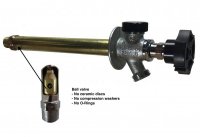Lvrpl
New Member
I've got a silcock that froze over the winter that I need to replace. I was hoping for some pointers on a few things:
1. Are there any brands in particular I should use or avoid? I've seen a couple mentions of Woodford, which they also sell at the big box stores - would those be decent? Any chance I can get a decent one at a big box? (That lets me do the repair on a Saturday since I need to match the length after I turn of the water and remove it.)
2. What's the simplest or best thing to use to fill the gap around the silcock flange and my brick? Right now, it looks like my front yard one is sealed with some mortar and hardened putty, and the back looks to be just some sort of hardened putty.
3. A friend helped me change the front yard one a few months ago and all we did is twist it off (it's threaded) and thread in the new one. I've now read that's a bad idea and one should get in the wall behind to use a second wrench to be sure you don't twist or break the supply pipe. How necessary is this? Did I just get super lucky on the front yard one?
Thanks for any help or advice.
1. Are there any brands in particular I should use or avoid? I've seen a couple mentions of Woodford, which they also sell at the big box stores - would those be decent? Any chance I can get a decent one at a big box? (That lets me do the repair on a Saturday since I need to match the length after I turn of the water and remove it.)
2. What's the simplest or best thing to use to fill the gap around the silcock flange and my brick? Right now, it looks like my front yard one is sealed with some mortar and hardened putty, and the back looks to be just some sort of hardened putty.
3. A friend helped me change the front yard one a few months ago and all we did is twist it off (it's threaded) and thread in the new one. I've now read that's a bad idea and one should get in the wall behind to use a second wrench to be sure you don't twist or break the supply pipe. How necessary is this? Did I just get super lucky on the front yard one?
Thanks for any help or advice.

